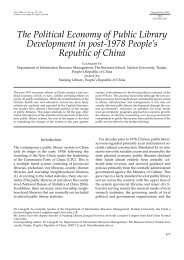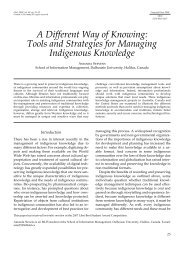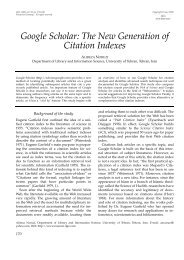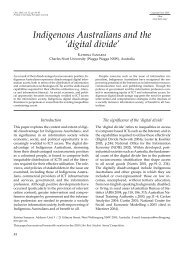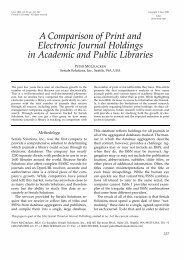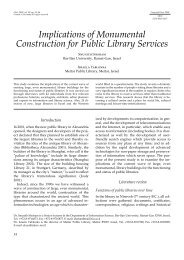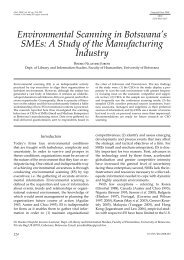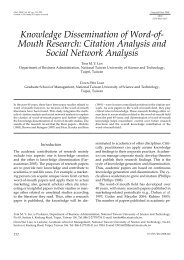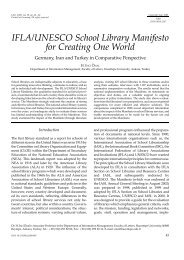Digital Libraries: A Conceptual Framework - Libri
Digital Libraries: A Conceptual Framework - Libri
Digital Libraries: A Conceptual Framework - Libri
You also want an ePaper? Increase the reach of your titles
YUMPU automatically turns print PDFs into web optimized ePapers that Google loves.
<strong>Libri</strong>, 1999, vol. 49, pp. 192–202Printed in Germany · All rights reservedCopyright © Saur 1999____________________________________________<strong>Libri</strong>ISSN 0024-2667<strong>Digital</strong> <strong>Libraries</strong>:A <strong>Conceptual</strong> <strong>Framework</strong>IAN ROWLANDS AND DAVID BAWDENDepartment of Information Science, City University London, UKThis article presents an approach to a conceptual frameworkfor understanding the concept of digital libraries. A typologyof digital library research is described, based on Yates’model of information work, and comprising three interlinkeddomains: informational, technological and social. Aconceptual framework for digital libraries, or complex librariesin Walt Crawford’s (1999) terminology, is developedon this basis.IntroductionThe purpose of this paper is to propose and partiallyvalidate a high-level conceptual frameworkto aid in the better understanding of the idea of‘digital library’. It builds upon the examination ofconcepts, terminology and assumptions presentedin an earlier paper (Bawden & Rowlands 1999a).Both papers are based on a report commissionedby the British Library Research and InnovationCentre (Bawden & Rowlands 1999b), but extendthe scope of the material presented there, andinclude material not available when the initialreport was prepared.The value of conceptual frameworksAs the digital library concept becomes more firmlyembedded and assumes greater significance forpublic and organisational information policiesand strategies, so does the need for a higher levelframework to organise our understanding ofthese developments become more pressing.<strong>Framework</strong>s of the sort developed here may beused to accomplish the following:• compare and evaluate the outcomes of digital libraryinitiatives;• translate research findings, and experience in practice,in one country or sector to another;• help to define areas where further research is needed,and to guide research strategies;• help to identify hidden linkages and synergies betweendifferent research areas;• help bridge the ‘conceptual gap’ between research andpractice;• help to tease out the policy implications of digital libraryresearch.There is a close link between the frameworksused here, and certain kinds of conceptual modelsSimply defined, a model is anything which representsthose parts of reality considered for some purpose. Itstands in the place of reality in order that we can think,negotiate, play or experiment (Underwood 1996).The aim of this work is to use a model forthinking or, more precisely, for understanding; understandingthe meaning and relations of concepts.Such a model will necessarily be at a highIan Rowlands, Department of Information Science, City University, Northampton Square, London EC1V 0HB, UK. Tel: +44 207477 8389. Fax: +44 207 477 8584. Email ir@soi.city.ac.ukDavid Bawden is Course Director for City University’s MSc/Diploma course in Pharmaceutical Information Management,Department of Information Science, City University, Northampton Square, London EC1V 0HB, UK. Tel: +44 207 477 8390. Fax:+44 207 477 8584. Email: db@soi.city.ac.uk192
<strong>Digital</strong> <strong>Libraries</strong>: A <strong>Conceptual</strong> <strong>Framework</strong>level, and will deal with general ideas, ratherthan detailed processes or structures/products.Models and frameworks are more important inthe real world than is sometimes acknowledged,since they shape the way we look at reality andframe the language we use to describe it. JohnMaynard Keynes wrote “practical men, who believethemselves to be quite exempt from anyintellectual influences are usually the slaves ofsome defunct economist”. In attempting to simplifythe complexities of the digital library, wehave necessarily been highly selective about thoseaspects of reality we have decided to project andemphasise and those we have played down.Models of this sort have had limited applicationto the digital library area, though Brophy(1999) points out the value of models for the digitallibrary in establishing the linkages betweenfunctions, and in providing a holistic view. Brophyand Fisher (1998) note the obsolescence of a‘holdings’ model and the inadequacies of a ‘systems’model, and favour a view of the library asan ‘expert intermediary’ between users and information(see also Lagoze & Fielding 1998). Mostmodels have largely taken the form of systemand function block diagrams (see Brophy (1999)for a comparison of several). An alternative simplerform of model has been one that presentsalternative conceptual views of the digital library.For example, there is Borgman’s (1999) three-wayview:• digital libraries as content, collections and communication;• digital libraries and institutions or services;• digital libraries as databases.A still simpler form of model is the metaphor, anumber of which have been used with respect todigital libraries, ‘hybrid’ library being the mostobvious. A newer metaphor is the information‘landscape’ or ‘ecology’, discussed with respectto the digital library by Lynch (1999) and byDempsey (1998).The scope and structureof digital library researchAn initial review (1) of the scholarly and professionalliterature relating to digital library researchrevealed eight thematic clusters:documentstechnologyworkFigure 1: Yates’ work-oriented library model• human factors;• organisational factors;• library management factors;• information law and policy factors;• systems factors;• knowledge organisation and discovery factors;• impacts on the information transfer chain;• futures studies and scenarios.These clusters reflect contrasting approaches tothe study of digital libraries and the highly multidisciplinarynature of the research questionsposed. The conceptual framework that we develophere recognises that diversity by adoptinga work-oriented perspective based on the workof Yates (1989). Yates (see Figure 1) highlights threecrucial aspects that may be applied to the understandingof both traditional and digital libraries.<strong>Libraries</strong>, however much they differ outwardly,have one thing in common: they house and provideaccess to stores of documents, defined in thebroadest sense to include enduring communicativerecords. These documents are created andmaintained using technologies that have requiredconsiderable human investment to develop – fromthe printed book to the object-oriented database.And both documents and technologies are deployedthrough the institution of the library tosupport work – both the work of the researcherswho use the library and its own staff who providereader and other services.This simple framework emphasises the interconnectednessof documents, technologies andwork, and stresses the fact that technological advancesare not the only sources of innovation inthe digital/complex library.193
Ian Rowlands and David BawdenLevy and Marshall (1995) examine the consequencesof Yates’ model for the digital library.Technical infrastructure does not, in and of itself,constitute a digital library. That requires content –more specifically, managed collections of contentfor identified user communities. The major issuesin the evolution of the digital library: interoperability,scalability, deep semantic retrieval,preservation, etc., can all be seen to be highly dependentupon solutions which draw in a coordinatedfashion from the worlds of documents,work and technology.Other writers seem independently to havereached a broadly similar conclusion<strong>Digital</strong> libraries are best thought of as human resourcestreams that unite readers, authors, librarians and researcherswith electronic materials, resource streams,computer equipment and know-how (Covi & Kling1996).By stressing the importance of either technology or librarianship,commentators on the digital library havecreated a false dichotomy; digital libraries need librariansin partnership with domain and information technologyexperts (Matson & Bonski 1997).In this paper, the three elements of Yates’ modelhave been re-labelled as the informational (documents),the systems (technology) and the social(work) domains of the digital library. These domainsoffer a more meaningful grouping of thethematic clusters identified earlier, which arenow more clearly seen to be overlapping:Social domain• human factors (non-machine specific);• organisational factors;• library management factors;• information law and policy factors;• impacts on the information transfer chain;• futures studies and scenarios.Informational domain• knowledge organisation and discovery (e.g. metadata);• impacts on the information transfer chain (e.g. supply);• futures studies and scenarios.Systems domain• human factors (e.g. human-system interaction);• systems factors;• knowledge organisation and discovery (e.g. softwareagents);• impacts on the information transfer chain (technical);• futures studies and scenarios.We now make an attempt to summarise thekey issue evident in the recent professional literatureon the digital library, beginning with socialfactors, in the belief that many current digital librarydevelopments unduly emphasise questionsof what? and how? rather than why? It is notablethat much digital library research has been confinedto a single domain, and it may be that thishas contributed to the confusion of concepts, anddeficiencies in practical implementation.Research in the social domainResearch into the social contexts surrounding thedigital library (here defined broadly to includepsychological, cultural, organisational, economic,legal and policy elements) is characterised byhigh disciplinary and literary scatter. These areconsidered here under four main clusters of researcheffort:• information skills and literacy;• impacts on the nature of work;• impacts on organisations;• information law and policy concerns.Information skills and literacyThe advent of the digital library carries with it aneed to re-assess what the notion of literacyreally means at this point in history. The term carrieswide variation of meaning, and a considerableoverlap with other terms, such as libraryliteracy, network literacy and, most recently, digitalliteracy (Bawden 1999). It can, however, bestbe understood as a complex of skills and attitudes,involved in accessing, evaluating and usinginformation, where the information may wellbe obtained from a variety of sources and in avariety of formats. Such skills are of evident ne-194
<strong>Digital</strong> <strong>Libraries</strong>: A <strong>Conceptual</strong> <strong>Framework</strong>cessity in the complex environment of the digitallibrary; conversely such an environment is a richarena for developing such skills.A consensus seems to be emerging that learningin digital library environments encompassestwo distinct components: learning how to access,evaluate and use information resources; andlearning how to master and build on the ideasembodied within those resources. In its mosthighly developed form, information literacy hasbeen characterised by “free form learning andjust-in-time information delivery” (Weinberger1997).Impacts on the nature of workAn assumption, sometimes explicit, more usuallyimplicit, informing the design of the digital libraryis an idealised form of use: the lone researchersitting at a workstation. The origins ofthis conception probably derive by extension fromclient-server architectures and the ordered worldof systems thinking. Yet we know by observationand from experience that information seeking,research activities and library service are oftenhighly collaborative. Ehrlich and Cash, for example,note thatPeople seek information by communicating with membersof their communities; they look not only for materialsand specific answers, but for corroboration, new interpretations,and new methods of finding information ... allthis suggests that support for communication and collaborationis as important as support for informationseekingactivities and that, indeed, support for the formeris needed to support the latter (Ehrlich & Cash 1994).The social implications of the digital library areprofound. <strong>Digital</strong> technologies relax the constraintsof time and place in relation to how peoplework with one another. New organisationalforms are beginning to emerge, such as collaboratories,but the ultimate effects of these new waysof working are unknown. While some advocatesof the digital library see the elimination of thelibrary as place, this now seems an increasinglyextreme – and technologically determinist – positionto adopt.Methods for selection, acquisition, organisation,access and preservation in the digital library differconsiderably from those in traditional librariesand models of best practice need to be developedand promulgated. The focus among libraryconsortia is gradually shifting from integratedlibrary systems to digital library projects, resourcesharing, collective database licensing and documentdelivery, each of which implies considerablechanges to working practice. Indeed, someof the more alarmist pronouncements on the virtuallibrary foresee the elimination of intermediaries(search intermediaries, librarians, retailers,distributors and others) who merely ‘interfere’ inthe process of interchange between content creatorsand readers.Finally, the fragility of cultural memory in adigital age should not be underestimated. Thereare many thorny issues associated with the obsolescenceof digital media, the migration of datato other hardware and software platforms or generations,and legal and institutional barriers. Thisaspect has caused concern to many commentators:The difficulty and expense of preserving digital informationis a potential impediment to digital library development.<strong>Digital</strong> preservation is largely experimental andreplete with the risks associated with untried methods.<strong>Digital</strong> preservation strategies are shaped by the needsand constraints of repositories rather than users, currentor future (Hedstrom 1997).The term digital preservation is used two meanings,somewhat distinct: the preservation of materialscreated in digital form and the digitisationof analogue materials for access and preservation.The preservation of materials in the digitalcontext is more complex than in a traditional library,and involves several aspects (see, for example,Hedstrom & Montgomery 1998). Thesewill ideally be incorporated into life-cycle managementof digital information, from creationthrough storage, migration, and continuing accessfor so long as the resource is deemed to havevalue. Necessary tasks include not merely physicalpreservation. They also include the copying ofdigital materials in their original format from oldto new media of the same nature to preventphysical deterioration (refreshing); the periodictransfer of digital materials from one system(hardware and/or software) to another, or fromone generation of computing equipment to thenext, to prevent technological obsolescence (migration);and possibly also the archiving ofequipment.195
Ian Rowlands and David BawdenImpacts on organisationsThe impact of the digital library on existing institutionsand institutional structures is anotherfocus of serious interest, not least in relation tothe future role and place of traditional libraries.Positions on this issue range from those held bytransformists who foresee the disappearance ofthe physical library and its phoenix-like re-manifestationin completely virtual form, to continuistswho stress resistance to change, inertia and ‘moreof the same’. The critical factor in this equation ispeople<strong>Digital</strong> library proponents must consider the role of people(as users and service providers) if the digital library isto be truly beneficial. Technology and information resources,on their own, cannot make up an effective digitallibrary (Sloan 1998).The culture change implied is something morethan merely a change in routine, or in the particulartasks to be done; rather this implies amore far-reaching change of ethos and values, reflectingin a need for new skills, knowledge andattitudes. This may include users becoming moreself-reliant in their information seeking and usingbehaviour, while librarians will become providersof systems, resources and interfaces. This, however,may be an oversimplification of the situation,ignoring for example the role of the libraryin providing a focal point in organisational, local,and national life (Tsuno et al. 1998, Collins 1998).Information law and policy concernsThe migration to an increasingly digital libraryinfrastructure throws up many legal and policyissues widely discussed in the literature. Theserelate, inter alia, to information integrity; documentauthenticity; user confidentiality; userauthentication (Lynch 1997); payment systems;security; encryption and personal privacy; and,not least, copyright management (Mann 1998).<strong>Digital</strong> libraries are evolving in a policy vacuumand against a background of great uncertainty.While it is clear that there is a need for focusedresearch into specific issues such as rights management,data privacy and digital signatures, the‘policy regime’ (Braman 1990) – an overarchingset of principles and values providing a commonframework of understanding – also needs to beaddressed from a digital library perspective.Research in the informational domainResearch within this domain has been focused onvarious aspects of resource description and subjectaccess:Information exploration in digital libraries involvesbuilding bridges between document space (the realm ofinformation artefacts, ranging from books to e-mails tobibliographic references) and concept space (the contextand knowledge required to interpret documents) (Baldonado1999).This concept of ‘information exploration’ subsumesa number of inter-related activities• accessing;• searching;• browsing;• navigating.These terms are used loosely in the literature.Generally access is taken to be the broadest term,implying both physical access – the resource isavailable by technical means – and authorisation– the user is permitted to access it.Searching generally implies a purposive identificationof items by criteria, subject or otherwise,which are clear to the user. Browsing and navigating,usually but not invariably, imply a moreloosely structured approach. Although more detailedtypologies of searching and browsing aredescribed (Bawden 1993, Large, Tedd & Hartley1999), they do not seem to have been much usedin studies of digital libraries, an exception beingthe writings of Bates (1998).Metadata, and resource description, is of centralimportance. The term metadata was, apparently,first used in the literature in 1962, andmade its first appearance in a dictionary in 1980(Bide 1999). Metadata is contentious because itsfunction is perceived very differently by librariansand computer scientists; the perspectives ofbibliographic control and data management respectively(Ng et al. 1997). A rich metadata structureis required in a digital library, with threefunctional categories, at the descriptive (or intellectual),structural, and administrative levels,the library cataloguing approach to metadata addressingonly the intellectual level. Metadatastandards are starting to emerge that may be-196
<strong>Digital</strong> <strong>Libraries</strong>: A <strong>Conceptual</strong> <strong>Framework</strong>come to digital libraries what MARC has been,and still is, to print libraries, the most notablecontender being Dublin Core (Dempsey & Heery1998).Information retrieval in distributed networkenvironments poses other challenges. The mostnotable of these is the degree to which informationretrieval can be made to operate at the levelof meaning (semantics), rather than charactermatching (syntactics) across large heterogeneousdocument collections. “Deep semantic interoperability”is a phrase that often crops up in digitallibrary vision statements, but precisely how weget there is far from trivial.Evaluating the performance of information retrievalsystems in distributed environments is anotherarea of concern, since it is clear that precisionand recall offer far from adequate measures of retrievaleffectiveness. New metrics, perhaps basedon the structural analysis of hypermedia networksand the browsing and navigational behaviour ofusers need to be developed and tested (see, forexample, Salampasis et al. 1998, Buttenfield 1999,Chowdury & Chowdury 1999).Research in the systems domainThe two issues that stand out most clearly in researchand development in the systems domainare interoperability and scalability. Co-ordinatedprogress in both areas is needed to deliver Hunt &Ethington’s vision of digital libraries that gives... full realization of the potential for infinite, integratedgrowth in materials, genres and formats (Hunt & Ethington1997).One reason that the question of interoperabilityhas received such wide attention is that theproblem permeates almost all aspects of digitallibraries that offer distributed access to diversematerials and formats. Interoperability has implicationsfor systems architectures, standardsand protocols for data transfer, metadata, andmark-up languages (Paepcke et al. 1998, Cole &Kazmer 1995, Healy 1998).The notion of interoperability therefore summarisesa wide variety of needs and procedures,requiring integration at a number of levels, fromphysical connection of equipment, throughstandard for format interconversion and resourcenaming, to the intellectual interoperability ofmetadata between resources. Brophy and Fisher(1998) distinguish five levels of interoperability:technical, semantic, political, inter-communityand international. Brophy (1999) adds accessibleinteroperability. <strong>Digital</strong> libraries of the future willinevitably be shaped by the technologies, standardsand models adopted today (Tennant 1997).The scalability of digital libraries, potentiallyto national and international dimensions, is onlypossible within the limits set by interoperabilitystandards (or the lack of them); the effort requiredto support a scaled-up service might alsobe a factor:Experience shows that failure to scale is one of the mostfrequent reasons for failure to turn electronic library experimentsinto viable services (Brophy and Fisher 1998).The future of digital libraries?There are many competing visions of what thedigital or virtual library will look like. One thingthat is certain is that the digital libraries of the futurewill be shaped by the technologies, standardsand models adopted today. Some commentatorsbelieve that current directions in digital libraryresearch and development are too conservative insome respects.Discussions of the digital library usually emphasise thetransition of scholarly information and libraries to the electronicmedium. To that extent, the discourse is framed inthe context of the print world we all understand. Most ofthe attempts to build ‘digital libraries’ build on theseanalogies. On the other hand, it is likely that this thinkingabout ‘transition’ is itself transitional and merely looks atthe past as a way to conceptualise the future. Such thinkingmay constrain opportunities in the new networkedworld (Lyman 1996).In other words, there is a danger that certainfeatures of existing libraries are being unreflectivelyconserved, as are certain features ofan idealised and unreal past. The future lies indeveloping new understandings between librarians,technologists and usersTo participate most fully, librarians will need the help oftechnologists to better understand the possibilities beingcreated by digital technologies, and technologists willneed the help of librarians to appreciate the richness oftraditional librarianship and to identify aspects of it thatare most relevant to the continuing evolution of libraries(Levy & Marshall 1995).197
Ian Rowlands and David BawdenUnderstanding digital libraries:a conceptual frameworkANALOGUELOCALLY-HELD COLLECTIONSDISTRIBUTEDCOLLECTIONSSome library modelstraditional libraryinterlending serviceslibrary cooperativesExactly what a digital library is and how it is to be organisedhave not yet been determined (Braude et al. 1995)electronic libraryhybrid libraryWe can distinguish three general models for thedevelopment of digital libraries. In general terms,these correspond to the digital library, the hybridlibrary and the electronic library. The relativemeaning of these terms is discussed in a previouspaper – Bawden & Rowlands 1999a.The simplest, and the least likely to be a modelfor any current or future library service, is theelectronic library model. This envisages thelibrary as a physical place, in which users mayaccess digital resources one at a time. Theseelectronic resources are selected, acquired, andmade available for access and searching in verymuch the same way as traditional resources. Thisis a model of an incremental progress from traditionalto digital, but is very much an automationof the status quo. It is unlikely that anylibrary service would aspire to operate on such amodel, and it may be regarded as a warning ofthe wrong way to digitise. As Rusbridge pointsout, however, absurd though it may be, it is theonly model that can maintain anything like thetraditional relationship with publishers, and theeconomic implications of this.The hybrid library (Pinfield et al. 1998, Brophy& Fisher 1998, Oppenheim & Smithson 1999)is generally viewed by its proponents as a modelin its own right, to be developed and improved,though it may be viewed by others as a transitionalstage towards a truly digital library. Thismodel represents the typical ‘real world’ situation,with pragmatic access to information from arange of media and formats, within an ideal ofever-closer integration and interoperability:it follows that most users will continue to be offered amix of formats via a mix of delivery systems. The challengefor library managers is to create integrated serviceswhich provide a ‘seamless’ service to the user. (Brophy &Fisher 1998)The hybrid library, since it has an element ofphysical provision, and by implication a physicallocation in which these are stored and accessed,DIGITALcomplex libraryFigure 2: Locating the digital library conceptdigital libraryvirtual librarylibrary without wallsseems almost invariably to be an institutionalmodel. In this way, it preserves the general conceptof the traditional library, and, almost incidentally,retains the notation of the library asplace; although there is considerable debate inthe literature as to whether such an entity isproperly regarded as primarily a place or a distributedprocess. Be that as it may, it seems clearthat there will be a physical location associatedwith a hybrid (or gateway) library. The value ofthis should not be under-estimated, whether asthe provision of space for student study in aneducational institution, for community activitiesin a public library, or for knowledge managementin a commercial organisation, for which the physicalconditions for knowledge sharing are beingincreasingly recognised as important. The hybridlibrary, for the same reasons, has an extendedtemporal existence. Figure 2 summarises the relationshipbetween traditional, electronic, hybridand digital libraries in a two-dimensional space,which emphasises relative degrees of distributedaccess and digital content.The digital library proper may be based on aninstitution, but equally it could be based on asubject discipline, a vocation or profession, a regionor even a nation. While such an entity mayhave a physical location, it need not. It may becalled into existence very rapidly, and dispersedequally rapidly; indeed it has been suggestedthat such ‘limited life’ digital libraries could be acreated as a response to, for example, medical orenvironmental emergencies. The true digital libraryalso has within it the capability to disruptand reconstruct the publishing and knowledge198
<strong>Digital</strong> <strong>Libraries</strong>: A <strong>Conceptual</strong> <strong>Framework</strong>creation system. This being the case, providingrealistic models for this type of library is muchmore difficult that for the previous two, purelyon account of its dynamic, multifaceted and multichoicenature. One approach, which seems to encompassmuch thought in this area, suggests thata model of the digital library should comprisefour structural levels:• user interface;• networks and communications;• information resources;• reference service systemsupporting five basic kinds of functionality:• digitisation;• large repositories;• fast data transfer;• privilege;• management (Yang and others 1997).Models of the digital library per se are, however,inadequate, if they do not allow modellingof the change in the nature of publication due todigitisation; traditional library models, assuming‘traditional’ acquisition inputs, are necessarilyinadequate. An example of this is a hybrid publishingmodel, with greater interconnection ofprint and web publications and further developmentof value-added services on the Web version(MacColl 1997).Three separate general models are suggestedabove, corresponding to what we have termedthe electronic, hybrid and digital library respectively.These may be combined into one overallgeneral model, using Crawford’s (1999) conceptof the complex library, discussed in a previouspaper (Bawden & Rowlands 1999a).We consider that Crawford’s concept of thecomplex library is a useful one, to cover all thosesystems and services having a degree of digitisation.For one thing, it is eminently descriptive ofthe complicated situations with which librarians(and researchers) must cope. It avoids the negativeconnotations of ‘hybrid’, with its suggestionof an awkward transitional phase; Collier (1997)also criticises the ‘hybrid’ metaphor, since it ‘simplyexpresses the obvious’. It is also possible, andhelpful, to use an analogy with the mathematicalResearch, development, scholarshipINFORMATIONALDOMAINPilots, demonstrations, live applicationsFigure 3: <strong>Digital</strong> library research: theory and practiceconcept of complex number, by which all numbersare thought of as including a real part andan imaginary part. By analogy we may think of acomplex library as comprising both real and virtualcomponents. A traditional library, a physicalplace with a collection of physical informationitems, would have a real component, but no virtualcomponent. A hybrid library would includeboth components, in varying degree. A truly digitallibrary would be entirely virtual, with no real(physical) components whatever. It is interestingto speculate whether such a thing could exist; inits full sense it would, of course, have to have nostaff, and be serviced by virtual agents. Perhapsthe closest approach to it that could currently beenvisaged in practice is a collection of digital resources,brought together for a particular need,without any institutional focus, nor any staffdedicated to it.Theory and practiceSYSTEMS DOMAIN<strong>Digital</strong> library literature includes examples bothof original academic research and opinion papersby library practitioners. The relationship betweenresearch (the world of ideas) and the real worldof pilot and demonstration projects and digitallibrary innovation is represented below. In fact,reality is more fluid and dynamic than Figure 3suggests; ideas flow up as well as down, andsometimes cross over from one domain to another.The fluidity of the transfer of technology betweenresearch, development and practice in thefast-moving world of the evolving digital libraryis a topic itself worthy of further attention.SOCIAL DOMAIN199
Ian Rowlands and David BawdenIintroduceIIexploreIIIintegrateIVdiffuseVexploitINFORMATIONAL FACTORSDESIGN IMPLEMENT EVALUATESYSTEMS FACTORSSOCIAL FACTORSFigure 4: The digital library life cycleFigure 5: Feedback mechanisms in the evolution of digitallibrariesEvaluating the digital libraryIn this section we look at two models which mayhelp to clarify some of these questions. Figure 4 isadapted freely from the work of Edna Reid(1999), who has clearly been deeply influenced inturn by Michael Scott-Morton’s pioneering bookThe Corporation of the 1990s (1991). Reid’s is a fivelevelmodel, which might be used to classify digitallibrary pilots and initiatives based on thestage reached at a particular point in time as theyroll out in the organisation.<strong>Digital</strong> library demonstrations and pilots arefirst introduced (I), then explored more fully inthe work setting (II), gradually integrated withother services such as document delivery (III),then more widely diffused both within and acrossorganisations (IV), and finally exploited to securesome kind of business advantage (V).This process of rollout and exploitation naturallyinvolves solving and ameliorating problemsas they arise in the informational, systems andsocial domains. For example, the diffusion of adigital library application across different departmentsof the same organisation may involve publishinglocal databases in a standard form (theinformational domain), solving problems raisedby legacy hardware and software (the systemsdomain) and encouraging staff to change longstandingpatterns of work practice (the social domain).Barry (1997) identifies five key issues in theevaluation of digital library initiatives:• incomplete knowledge of the operating variables inthis new area;• the complexity of the information search process;• the implicit nature of information and research skills;• the difficulty of measuring outcomes, say in researchterms;• incomplete knowledge of the role information systemsand services play in supporting research.Figure 5 further stresses the temporal aspectsof digital library developments and, especially,the need for evaluation, reflection and analysis.Feedback loops, between design, implementationand evaluation (involving users) and betweenthe world of ideas and the world of practice needto be better understood, and facilitated wherenecessary.This is a far from trivial problem. <strong>Digital</strong> librarypilot and demonstration projects differenormously in their assumptions, terms of reference,degree of component autonomy, taskcomplexity and scale. Comparing outcomes isenormously difficult, especially in the face of developmentsthat by their very nature draw onconcepts of heterogeneity, federation and interoperability.The lack of robust and commonlyagreed criteria for evaluating various aspects ofthe performance in the digital library is a causefor concern and represents an area where moreresearch is urgently needed.The conceptual frameworkFinally, we synthesise some of the main pointspresented so far in the form of our conceptualframework (Figure 6). This relates the worlds ofideas and practice to a dynamic conception of thedigital library with a strong temporal aspect (left-200
<strong>Digital</strong> <strong>Libraries</strong>: A <strong>Conceptual</strong> <strong>Framework</strong>WORLD OFPRACTICETECHNOLOGYTRANSFERWORLD OFIDEASDESIGNIMPLEMENTintroduceexploreintegratediffuseexploitSOCIAL DOMAINInformation skills and literacyImpacts on organisations and the nature of workInformation law and policyINFORMATIONAL DOMAINKnowledge organisation and discoveryImplications for information transfer chainSYSTEMS DOMAINHuman-computer interactionSoftware agentsSystems architecturesFEEDBACK LOOPSFigure 6: Understanding digital librariesright) and informed by ideas rooted in Yates’notion of documents, technologies and work.We believe this framework summarises manyimportant issues in digital library research, notleast the need for greater reflection and evaluation,a more transdisciplinary approach, and closerco-operation between academic, practitioner, userand policy-making communities. It should providea valuable tool for understanding the natureof digital libraries and for comparing and analysisthe results of research and the experience ofpractice.ReferencesEVALUATEBaldonado, M. Q. W. 1997. An interactive structuremediatedapproach to exploring information in aheterogeneous distributed environment, PhD thesis,University of Colorado.Barry, C. A. 1997. Information skills for an electronicworld: training doctoral research students. Journal ofInformation Science 23(3): 225–38.Bates, M. J. 1998. Indexing and access for digitallibraries and the Internet: human, database and domainfactors. Journal of the American Society for InformationScience 49(13): 1185–1205Bawden, D. 1999. Information literacy, digital literacy,and other literacies; a review of concepts and models,submitted for publication.Bawden, D. 1993. Browsing: theory and practice. Perspectivesin Information Management 3(1): 71–85.Bawden, D. and I. Rowlands. 1999. <strong>Digital</strong> libraries:assumptions and concepts. <strong>Libri</strong> 49(4): 181–191.Bawden, D. and I. Rowlands. 1999. Understandingdigital libraries: towards a conceptual framework.British Library R&I Report No. 170.Bide, M. 1999. Introduction to metadata. Paper presentedat a British Computer Society meeting, London,10 March.Borgman, C. L. 1999. What are digital libraries? competingvisions. Information Processing and Management35(3): 227–43.Braman, S. 1990. Defining information: an approachfor policy-makers. Telecommunications Policy 13(3):233–42.Braude, R. M. et al. 1995. The organisation of the digitallibrary. Academic medicine 70(4): 286–91.Brophy, P. 1999. <strong>Digital</strong> Library Research Review. Libraryand Information Commission Report No. 17.London.Brophy, P. and S. Fisher. 1998. The hybrid library. NewReview of Information and Library Research 4: 3–15.Buttenfield, B. 1999. Usability evaluation of digitallibraries. In D Stern (ed.) <strong>Digital</strong> libraries: philosophies,technical design considerations, and examplescenarios. Binghampton, NY: Haworth Press, 39–60.Chowdury, G. G. and S. Chowdury. 1999. <strong>Digital</strong> libraryresearch: major issues and trends. Journal ofDocumentation 55(4): 409–48.Cole, T. W. and M. M. Kazmer. 1995. SGML as a componentof the digital library. Library Hi-Tech 13(4):75–90.Collier, M. 1997. Towards a general theory of the digitallibrary. URL http://www.dl.ulis.ac.jp/ISDL97/proceedings/collier.htmlCollins, S. G. 1998. Knowledge will forever govern ignorance:power and ideas of information society atthe Library of Congress. Ph.D. thesis. University ofWashington.Covi, L. & R. Kling. 1996. Organizational dimensionsof effective digital library use: closed rational andopen natural systems models. Journal of the AmericanSociety for Information Science 47(9): 672–89.Crawford, W. 1999. Being analog: creating tomorrow’slibraries. Chicago, IL: ALA Editions.Dempsey, L. 1998. Places and spaces. In Towards the<strong>Digital</strong> Library: the British Library’s Initiatives forAccess programme. London: British Library, 234–41.Dempsey, L. and R. Heery. 1998. Metadata: a currentview of practice and issues. Journal of Documentation54(2): 145–72.Ehrlich, K. and D. Cash. 1994. Turning information intoknowledge: information finding as a collaborativeactivity. In: <strong>Digital</strong> libraries 94 (College Station,Texas, June 19–21), 119–25.Healy, L. W. 1998. Library systems: current developmentsand future directions. Washington, DC:Council on Library and Information Resources.Hedstrom, M. 1997. <strong>Digital</strong> preservation: a time bombfor digital libraries. Computers and the humanities31(3): 189–202.201
Ian Rowlands and David BawdenHedstrom, M. & S. Montgomery. 1998. <strong>Digital</strong> preservationneeds and requirements in RLG memberinstitutions. URL: http://www.rlg.org/preserv/digpres.htmlHunt, L. & P. J. Ethington. 1997. The utility of spatialand temporal organization in digital library construction.Journal of Academic Librarianship 23(6):475–83.Large A, L. A. Tedd and R. J. Hartley. 1999. Informationseeking in the online age. East Grinstead:Bowker-Saur, chapter 7.Levy, D. M. & C. C. Marshall. 1995. Going digital: alook at assumptions underlying digital libraries.Communications of the ACM 38(4): 77–84.Logoze, C & D. Fielding. 1998. Defining collections indistributed digital libraries. D-Lib Magazine, (November).URL: http://mirrored.ukoln.ac.uk/lisjournals/dlib/dlib/dlib/november98/lagoze/11lagoze.html#RA96Lyman, P. 1996. Access is the killer application. Journalof Academic Librarianship 22(5): 371–75.Lynch, C. 1999. Civilising the information ecology. InInformation landscapes for a learning society,S. Criddle, L. Dempsey and R. Haseltine (eds.).London: Library Association, 257–67.Lynch, C. A. 1997. The changing role in a networkedinformation environment. Library Hi-Tech 5(1/2): 30.Mann, T. 1998. Reference service, human nature, copyrightand offsite service in a ‘digital age’? Reference &User Services Quarterly 38(1): 55–61.MacColl, J. 1997. The hybrid magazine in the hybridlibrary. New Review of Information Networking 3: 117–24.Matson, L. D. and D. J. Bonski. 1997. Do digital librariesneed librarians? An experimental dialog. Online21(6): 87–92.Ng, K. B. et al. 1997. Control or management: a comparisonof the two approaches for establishingmetadata schemes in the digital environment. Proceedingsof ASIS 34: 337–46.Oppenheim, C. and D. Smithson. 1999. What is thehybrid library? Journal of Information Science 25(2):97–112.Paepcke, A. et al. 1998. Interoperability for digital librariesworldwide. Communications of the ACM41(4): 33–43.Pinfield, S. et al. 1998. Realising the hybrid library. D-Lib Magazine (October). URL: http://mirrored.ukon.acuk/lis-journals/dlib/dlib/dlib/october98/10pinfield.html]Reid, E. O. F. 1999. The Internet and digital libraries:implications for libraries in the ASEAN Region.URL: http://www.apmforum.com/alf/diglibs.htmRusbridge, C. 1998. Towards the hybrid library. D-LibMagazine (July/August). URL: http://www.dlib.org/dlib/july98/rusbridge/07rusbridge.htmlSalampasis, M. et al. 1998. Evaluation of informationseekingperformance in hypermedia digital libraries.Interacting with Computers 10(3): 269–84.Scott Morton, M. S. 1991. The corporation of the 1990s:information technology and organisational transformation.New York: Oxford University Press.Sloan, B. G. 1998. Service perspectives for the digital library.Library Trends 47(2): 103–17.Tennant, R. 1997. <strong>Digital</strong> libraries: the grand challenges.Library journal 122(20): 31–32.Tsuno, K. et al. 1998. <strong>Digital</strong> libraries and citizens’rights. Toshokan Zasshi 92(5): 336–56.Underwood, P. G. 1996. Soft systems analysis and themanagement of libraries, information services andresources centres. London: Library Association Publishing.Weinberger, M. I. 1997. Just-in-time learning with electriclibrary. Library trends 45(4): 623–38.Yang, Z. et al. 1997. The architecture of a digital libraryprototype. Journal of Educational Media and LibrarySciences (Shanghai Jio Tong University) 35(1): 77–92.Yates, J. 1989. Control through communication. Baltimore,MD: Johns Hopkins University Press.Notes1. The review covered the period 1995 to the presentand was based on materials indexed in the followingonline files: Science Citation Index, SocialSciences Citation Index, Library & Information Abstracts,Information Science Abstracts, EducationalResources Information Centre, Dissertation Abstractsand Applied Social Sciences Abstracts. Additionalresearch was carried out on the WorldWide Web using AltaVista. Some earlier materialsare included where appropriate.202



